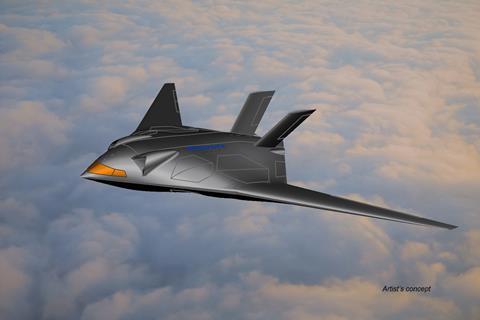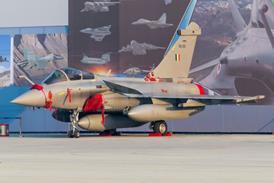The second of four designs has been revealed in the Speed and Runway Independent Technologies (SPRINT) X-plane competition being held by the Pentagon’s secretive technology development agency.
The US Defense Advanced Research Projects Agency (DARPA) is providing funds to four aerospace manufacturers to develop novel aircraft capable of achieving fixed-wing jet speeds, while also offering vertical take-off and landing (VTOL) capability.
Boeing subsidiary Aurora Flight Sciences on 15 November became the second competitor to publicly reveal its approach to solving the SPRINT challenge.

Aurora’s strategy will use a blended-wing-body airframe that incorporates fan-in-wing rotors to provide vertical lift – a “high lift, low drag” design with embedded engines and moderate sweep, Aurora notes.
The vertical-lift fans will be linked to the craft’s main engines via mechanical drives.
“The aircraft would deliver game-changing air mobility capability by combining cruise at over 450kt [830km/h] with vertical take-off and landing in a single platform,” Aurora says.
The four winners selected for Phase 1A of the SPRINT programme – those led by Aurora, Bell-Textron, Piasecki Aircraft and Northrop Grumman – have received contracts to fund initial concept designs, with the potential for additional funding for design maturation, aircraft development and eventual flight testing.
DARPA is partnering with US Special Operations Command (SOCOM) on the project. In May, SOCOM’s head of acquisitions Jim Smith told FlightGlobal that the USA’s elite troops are looking for a fast transport that can operate without runways or other ground infrastructure.
“We think it fits very well into ensuring we can move long distances, in operationally relevant times to support our forces,” Smith said of the SPRINT project.
DARPA X-plane projects are typically intended to foster creativity and innovation amongst participants, outlining only a general problem set and basic performance requirements.

Aurora is participating in two other X-plane projects being administered by the technology development agency: the Liberty Lifter programme to develop a heavy-lift seaplane, and a separate effort called Crane, which aims to mature so-called “active flow” aircraft that can manoeuvre without traditional mechanical flight control surfaces.
Aurora’s fan-in-wing approach to SPRINT differs dramatically from a competing design already under testing by helicopter manufacturer Bell.
The producer of the V-22 Osprey tiltrotor is seeking to build upon its experience pioneering that variable flight mode VTOL platform with a concept Bell calls High Speed Vertical Take-Off and Landing (HSVTOL).
The concept envisions an aircraft that looks like a tiltrotor while on the ground and in vertical flight. However, while other tilt-rotor aircraft – like Ospreys and Bell’s V-280 Valor – have only propellers providing horizontal thrust, HSVTOL would have a third, jet-powered mode of travel. In that mode, the aircraft’s rotor blades would be retracted.
Bell has been developing the concept since at least 2017, when it filed a patent for a tiltrotor with folding rotor blades. The company began sled testing the novel propulsion system in September.
Aurora’s vice-president of aircraft development Larry Wirsing argues his company’s approach will demonstrate “that a high-speed, vertical lift, blended-wing-body aircraft will provide superior flexibility and operational performance”.
DARPA expects to announce the next round of SPRINT funding in May 2024.
The agency notes it may advance as many as all four competitors or none, depending on design promise and progress toward achieving programme goals.


























